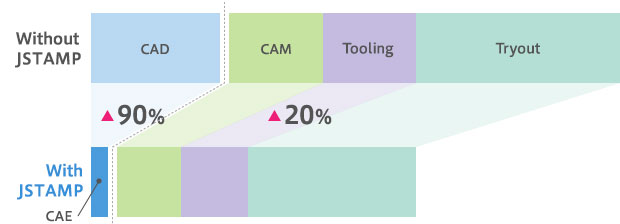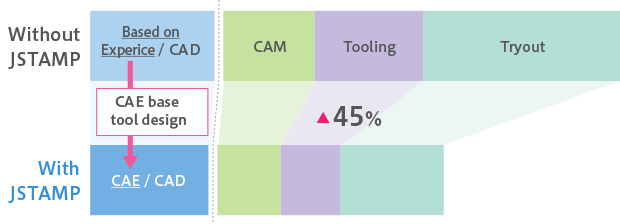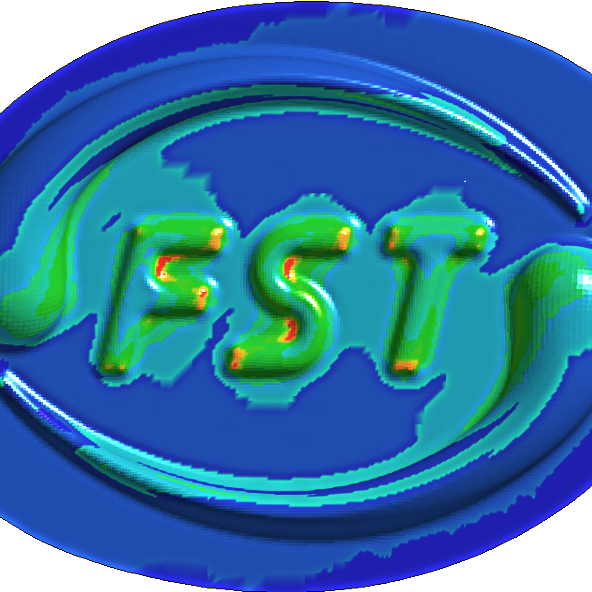J Stamp
- home / J Stamp
JSTAMP is a LS-DYNA based, stamping specific software from JSOL in Japan. A virtual simulation tool for Sheet metal forming process.
JSTAMP provides comprehensive support throughout the design process from the first trial to the final stage. JSTAMP has features resolving issues with complicated process stages as well as low formability materials.
Users can examine simulation results, output results to CAD, and directly use CAD files for further processing.
Overview
Design Support
Reduce dieface lead time and the cost of tool design
Accurate Prediction
Avoid the challenges and costs of trial and error with crack, wrinkle, and springback prediction
Formability
Quickly compute formability evaluations on complex models
CAD output
Output springback compensated tooling surfaces as CAD files
Material Database
Detailed Material Database as part of the standard included equipment
Blank/Trim Line Development
Effective Iterative method of predicting the blank/trimline
Features
- Fully integrated shell element
- Y-U kinematic hardening model (standard feature, material DB is available as an additional paid option)*
- Ductile failure evaluation (Cockcroft-Latham, Oyane, etc)
- Leading-edge FEM technologies to describe crack/wrinkle accurately.
- Parallel processing to deal with tens of thousands of meshes.
- Precise springback simulation module.
- Based on Yoshida-Uemori Material Model
- Able to consider various conditions
- Bauschinger effect
- Plastic Strain dependency of unloading Young’s Modulus
- Ability to deal with high tensile materials.
- Adaptive remeshing and coarsening
- Parallel computation (MPP, SMP), Implicit MPP
- HYSTAMP (One-Step Inverse Analysis Solver)
- Formability evaluation in product design phase
- Initial tool design support
- Blank line development
- Trim line development (flange development)*
- Drawbead/Pad pressure
- Line auto-prediction: Blank/Trim Line Development
- Estimated blank line development within tens of seconds
- Estimated trim line development within several minutes
- Quick and convenient calculations that improve the yield potential of press products
- Auto-prediction feature
- Automated successive simulation run for a multi-stage high-precision simulation
- High-precision simulation for ironing, Coining, Burring
- Gravity loading, Forming, Drawing, Trimming, Bending
- Springback
- User-defined process template creation
- Die actions
- Single/Double/Triple actions, Four-piece
- Drawing, Forming, Cum, Restriking, Trimming/Piercing
- Forming pressure control
- Rotary tool
- Material models (Anisotropic plasticity, Anisotropic yield function, Bauschinger effect, Strain rate dependency, etc)
- Material database (over 300 materials)
- Steels, SUS, aluminum alloy
- User defined material database compatibility.
- Tailored blank
- Accurate tool mesh
- Tool mesh lumping modification
- Fine trim mesh
- Half model and quarter model simulation
- EQ (equivalent) drawbead
- Cracking and Wrinkle prediction
- Sheet thickness, Thinning distribution
- Strain distribution
- Display forming limit diagram, Stress curve (FLD, FLSC), history
- Drawing circle grids
- Display curvature
- Forming load (Working pressure, Cushion pressure) prediction
- Display tool pressure, Contact area
- Material fitting
- Amount of material inflow, Inflow direction, Tracing
- Material stretching
- Shock line, Gap
- Blank line development, Trim line development
- Cross-section evaluation
- Geometry measurement
- Thickness distribution on a deformed cross-section
- Reflect display
- Animation output (AVI, MWV)
- Automatic report generation
- SmartPost (post viewer) output (JSOL provides SmartPost free of charge)*
- Evaluation of measurement by clamp simulation
- Surface defect evaluation (simulate oil stone inspection)
- Re-analysis
- Fillet radius expansion
- Springback-compensated tool creation*
- Compensated CAD surface output (IGES, STEP format)
- Compensation using scanned data of a trial panel
- Thickness, Thickness reduction evaluation
- Thermal-Structural Interaction Analysis
- Quenching evaluation, Hardness evaluation, CCT curve diagram
- Tool cooling analysis (capable of multishot)
- JSTAMP can consider the temperature dependency of a material
- Find heat transferred to the tool by using thermal-structural interaction analysis.
- Tube hydroforming*
- Sheet hydroforming (Hydraulic Counter-pressure Forming)
- Self-developed simulation solver to facilitate fast computation of bending process without any tool data.
- Simulated compensated tools can be output to CAD.
- Output is used directly in CAM to pass evaluated result to the following process
- Expansion of tool radius and CAD Output
- Users can modify fillet R parametrically without going back to CAD data.
- Modified idea can be output into IGES format, which can be mapped to the original CAD data.
- Users can modify fillet R parametrically without going back to CAD data.
- CAD data auto healing (spGateAuto)
- IGES, JAMA-IS
- CATIA V4/V5*
Virtual Evaluation of Countermeasures
CAD output for SB-compensated tools and expansions of tool radius
Realistic Reproduction of Forming Process and Evaluation
Crack/Wrinkle Evaluations, Springback Analysis and Geometry Evaluation, Ironingdeep Drawing, Material Databases
Operability and Work Efficiency
Multi-stage Simulation, User friendly execution control, Tool actions, Repeated simulation support, Project templates, and Smartpost File Support
Notable Case Studies
An anonymous mold manufacturing company located in Kanagawa
prefecture, Japan, started to use JSTAMP/NV in 2003 to respond to
customers’ QCD needs.
The main target is the tool for mass-production of sheets measuring less than 1 mm in thickness.
Applying CAE reduced the workload to 1/10th of the original and improved the accuracy up to a gap of +/-1.0 mm. The loss of workload in the tool manufacturing process was reduced dramatically.

To read more about this case study, Click Here
Ooturu Co., Ltd., a manufacturer located in Kanagawa prefecture, Japan, builds trial products to order. The company’s major customers are automotive engineering companies in Japan, including Honda Engineering Co., Ltd., Nissan, and Toyota.
JSTAMP/NV has been used since 2003 to deliver trial tools quickly. Considering the characteristics of the trial products, Ooturu Co., Ltd. uses laser shearing and applies JSTAMP/NV only for tool manufacturing.
Previously, the manufacturing process and the drawing geometry were determined using the mold of the product geometry. The process of trial and error led to the loss of many workloads and days. By applying CAE to the process, Ooturu Co., Ltd. could reduce the loss by half.
For Ooturu, CAE covered the lack of experience of the young engineers and improved the manufacturing process. With the help of CAE, better manufacturing processes could be suggested to the customer.

To read more about this case study, Click Here
